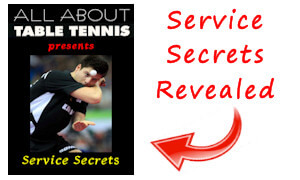You Are Here: Home » How to Play Table Tennis » The Block Stroke
Table Tennis Techniques
The Block Stroke
Improve your game with my top table tennis techniques and tips.
Are your reflexes quick enough to master the block shot?
By Martin Hughes
Owner and Editor
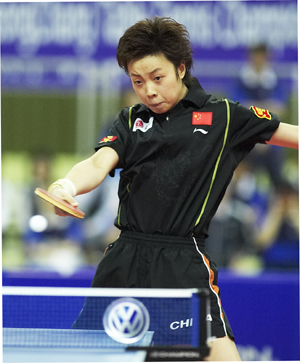 by courtesy of the ITTF
by courtesy of the ITTF
The modern game of table tennis is dominated by players who use an attacking / offensive style of play with very fast aggressive shots.
So one of the ways to counteract these aggressive shots is to use the table tennis technique of blocking the ball.
The block stroke is normally used when the approaching ball is moving very quickly towards you with heavy topspin, and the purpose of this stroke is to catch your opponent out of position and reduce the time available for them to play their next shot.
TABLE TENNIS EXPERT
REVEALS HIS SECRETS
Click Here For Details
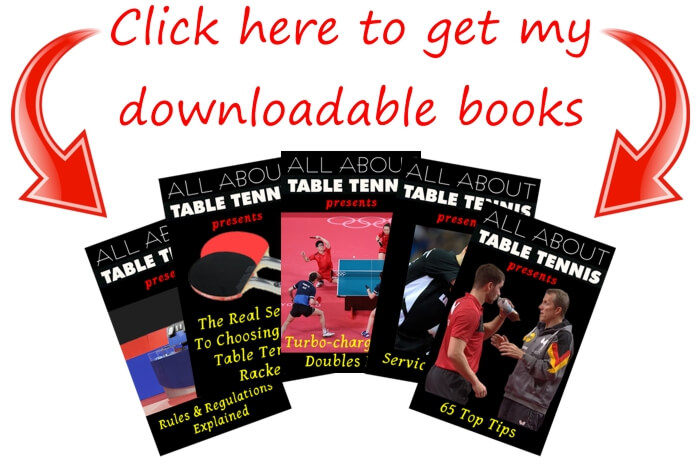
Click here for a large selection of
table tennis equipment at Megaspin *

Click here for a large selection of
table tennis equipment at Bribar *
^ Top of page ^
But first, a word of warning...
This is an advanced technique
Of course, coping with your opponent's fast attacking shots is an advanced technique, so it's important that you've mastered the basics of table tennis first, such as the table tennis grip, the basic table tennis strokes and the basic table tennis serve.
But once you've mastered the basics, you'll be ready to move on to an advanced level of table tennis.
If that's you, I hope you'll find these tips and techniques useful.
Within this section of my web site, I've also covered the following advanced table tennis techniques - mastering spin, the backhand and forehand loop, the smash, the lob, the backhand and forehand chop, and the advanced table tennis serve and return of serve.
You'll find all the links to these articles near the bottom of every page.
TABLE TENNIS EXPERT
REVEALS HIS SECRETS
Click Here For Details

Click here for a large selection of
table tennis equipment at Megaspin *

Click here for a large selection of
table tennis equipment at Bribar *
^ Top of page ^
OK, let's take a look at the technique required for...
The block stroke
1. The backhand block
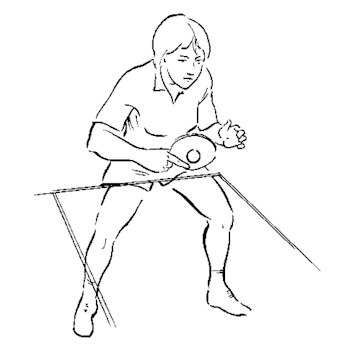
To play this stroke, stand close to the table and take a stance parallel to your end line, with your left leg slightly further forward than your right leg (for right-handed players).
Lower your centre of gravity by bending your knees.
Using a short stroke, your racket arm should move from the elbow in a horizontal plane and very slightly upwards, whilst your free arm should point forwards to assist with your balance.
Hit the ball in front of your body as it's rising (i.e. just after bouncing on your side of the table) with a slightly closed racket angle, using 50% of your stroke action before hitting the ball and 50% after hitting the ball.
Your racket angle will be determined by the amount of topspin imparted on the ball by your opponent.
The greater the amount of topspin imparted, the more closed racket angle you'll need to use.
Your body movement should be minimal when you play this shot.
My top table tennis techniques:
This shot would normally be used when the approaching ball is moving very quickly, with topspin, towards your backhand side.
The purpose of this stroke is to catch your opponent out of position and reduce the time available to them, so you should try to make sure that your shot lands away from your opponent and close to their baseline or sideline.
2. The forehand block
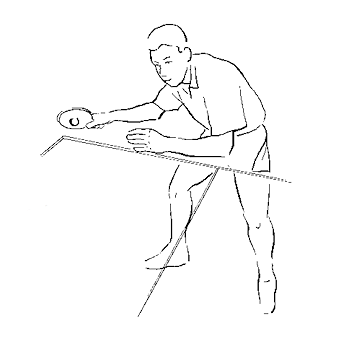
To play this stroke, stand close to the table and take a stance facing the line of play with your left leg close to the table and your right leg slightly further back (for right-handed players).
Lower your centre of gravity by bending your knees.
Using a short stroke, your racket arm should move from the elbow in a horizontal plane and very slightly upwards, whilst your free arm should point in the same direction as your racket arm to assist with your balance.
Hit the ball as it's rising (i.e. just after bouncing on your side of the table) with a slightly closed racket angle, using 50% of your stroke action before hitting the ball and 50% after hitting the ball.
Your racket angle will be determined by the amount of topspin imparted on the ball by your opponent.
The greater the amount of topspin imparted, the more closed racket angle you'll need to use.
Your body movement should be minimal when you play this shot.
My top table tennis techniques:
This shot would normally be used when the approaching ball is moving very quickly, with topspin, towards your forehand side.
The purpose of this stroke is to catch your opponent out of position and reduce the time available to them, so you should try to make sure that your shot lands away from your opponent and close to their baseline or sideline.
And here are a few...
Exercises to improve your block stroke
1. Get a partner, or a table tennis robot, to play fast topspin strokes diagonally across the table to your forehand or backhand corners, and practice playing a simple block stroke back to the same corner.
2. Get a partner, or a table tennis robot, to play fast topspin strokes to your backhand whilst you direct the ball back towards
a. the backhand corner, then
b. the middle line, then
c. the forehand corner.
Repeat this sequence.
3. Get a partner, or a table tennis robot, to play fast topspin strokes to your forehand whilst you direct the ball back towards
a. the forehand corner, then
b. the middle line, then
c. the backhand corner.
Repeat this sequence.
4. As your skills improve, practice varying the speed of your block stroke.
^ Top of page ^
Let's now see the block stroke in action and take a look at...
Advanced blocking techniques
The block stroke isn't thought of as one of the main strokes in the game and therefore it's a very under-rated one.
At the top level, most players are looking to play a fast attacking game, and the block isn't used as often as it is at lower levels.
However, it's an extremely effective stroke and I would encourage you to learn and perfect it with good practice using the advice given above.
And when you've mastered the basics of this stroke, you'll want to develop it into an even better stroke.
The top players
When you watch the top players you'll notice that they use many variations to the basic block stroke.
The basic block stroke will merely redirect the ball back to your opponent, and is probably just a reactive stroke, but an advanced stroke will be one where the player is trying to do something extra.
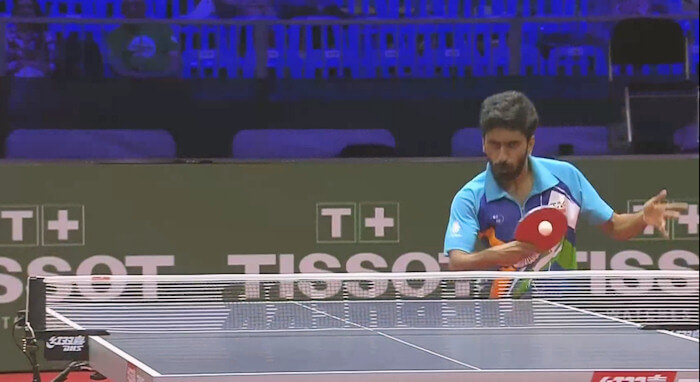 Sathiyan Gnanasekaran (India) playing a backhand block stroke
Sathiyan Gnanasekaran (India) playing a backhand block stroke
Variations to the basic stroke
The basic stroke is usually just about making contact with the ball and keeping it in play, because if the ball travels towards you extremely quickly, you may only have time to get your racket in the way and redirect the ball back to your opponent.
But the more advanced you become, the more you'll want to add something extra to your stroke.
For example, if you can hold the racket very gently, you can take the speed out of your opponent's stroke and play your stroke with less speed, or alternatively you can hold the racket firmly and exert additional speed by moving the racket in an aggressive forward direction.
Another variation is where you have time to aim the ball to a specific area of the table, or the natural angle of the approaching ball can help you to angle your return away from your opponent.
Another technique that's extremely effective is where you're able to impart sidespin onto the ball in addition to the topspin already present, and make the ball curve away from your opponent.
Examples by the top players
Take a look at these examples I've put together for you in this video.
The players featured here are all near the top of the world rankings, so it's unlikely that you'll be able to play the strokes as well as they do, but they demonstrate the many variations to the basic block stroke.
So keep practising the block stroke and before long you'll have an additional weapon in your table tennis armoury.
^ Top of page ^
| MORE PAGES ABOUT HOW TO PLAY TABLE TENNIS |
|---|
For more information on how to play table tennis and improve your game, take a look at my other tips and techniques articles...
Basic Skills
Advanced Skills
Strategies and Tactics
Tips
Skill Tests
Exercises
E-Books
|
Click here for a large selection of
table tennis equipment at Megaspin *

Click here for a large selection of
table tennis equipment at Bribar *
^ Top of page ^
You Are Here: Home » How to Play Table Tennis » The Block Stroke
